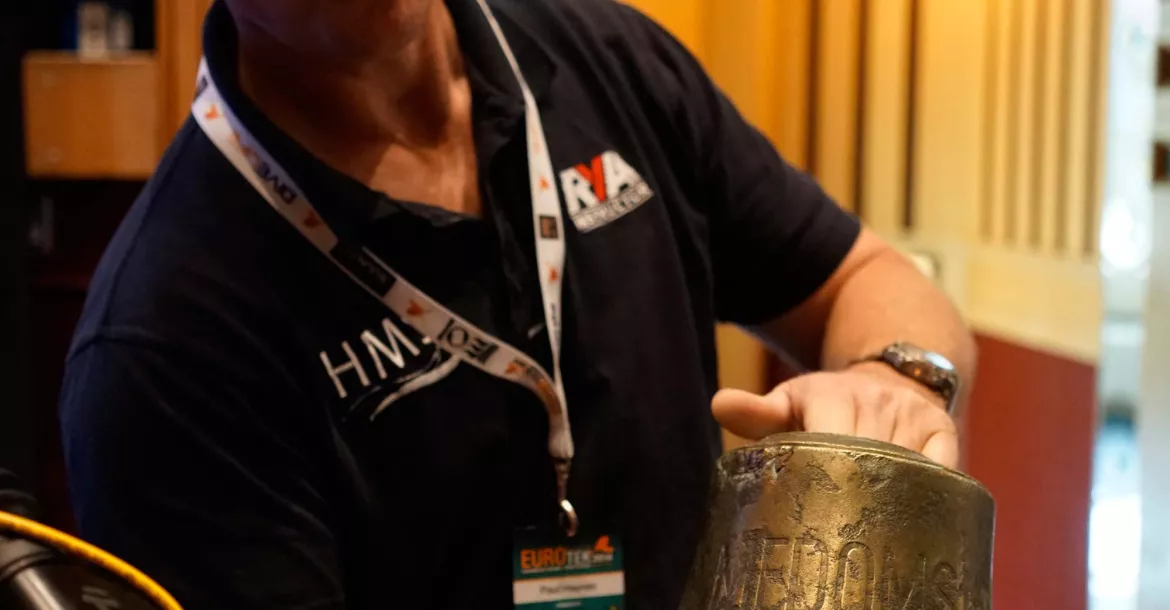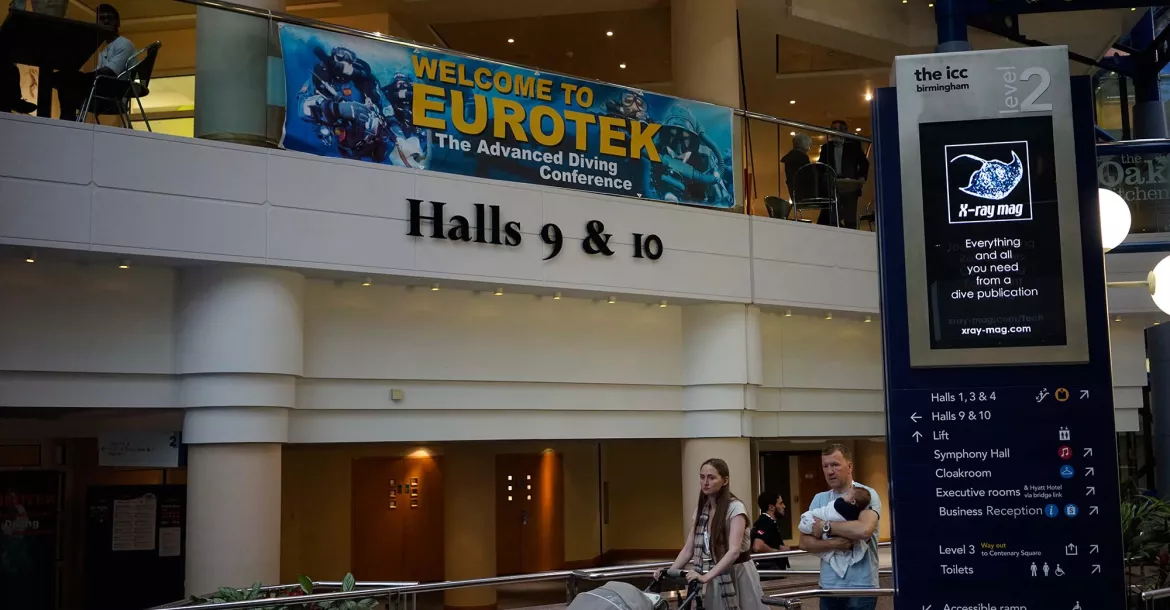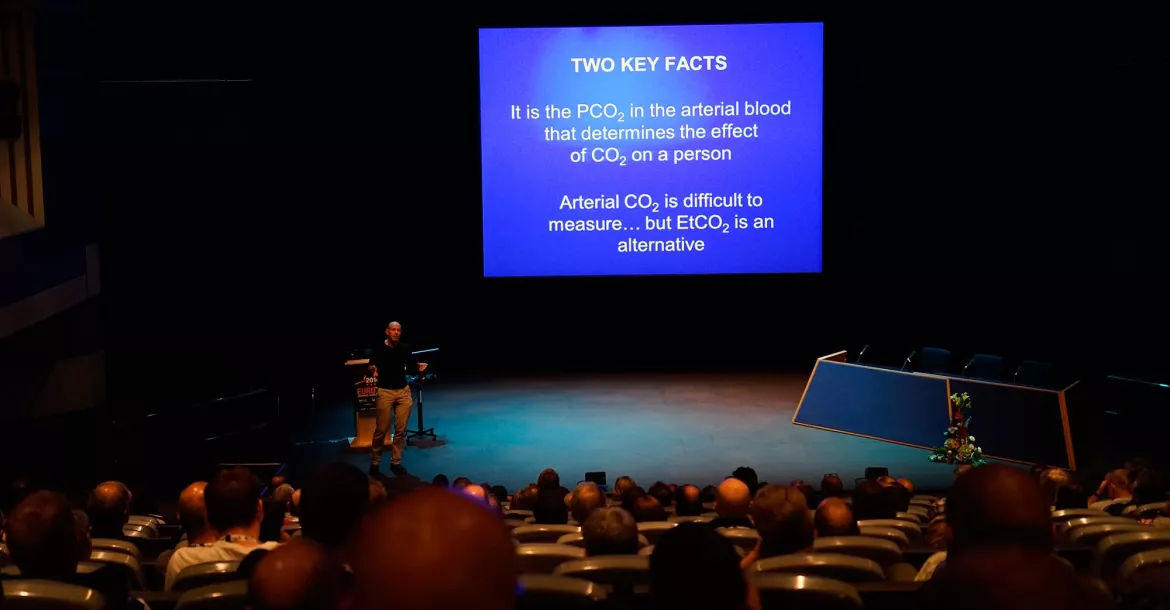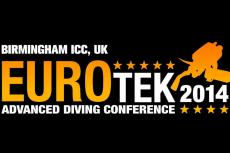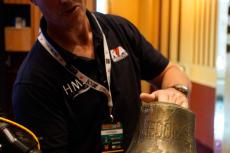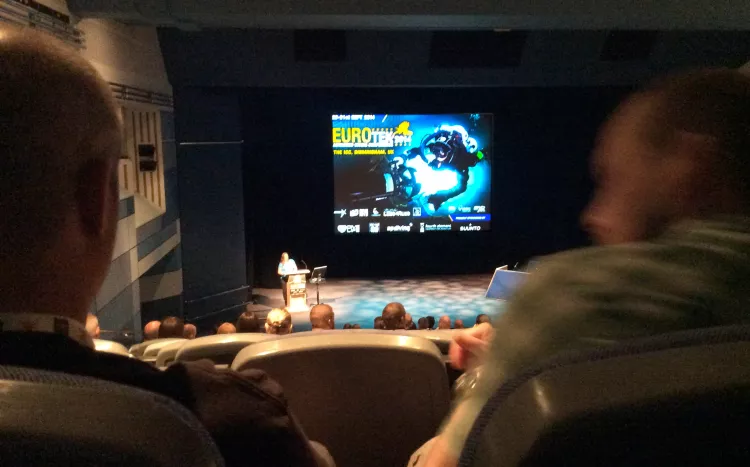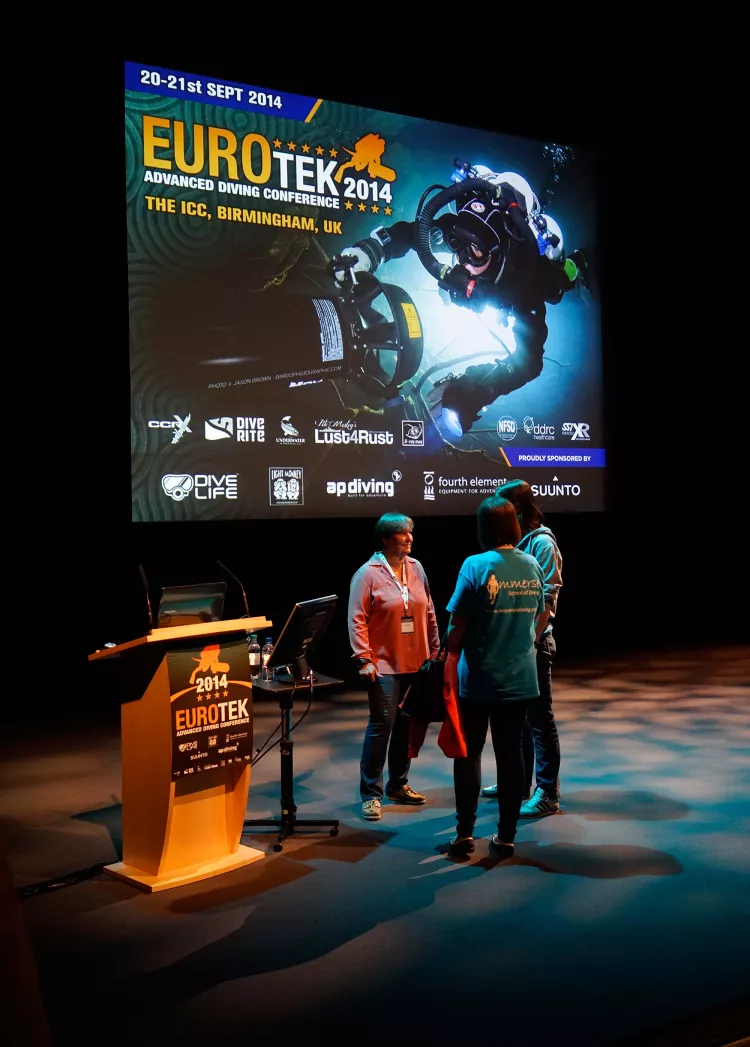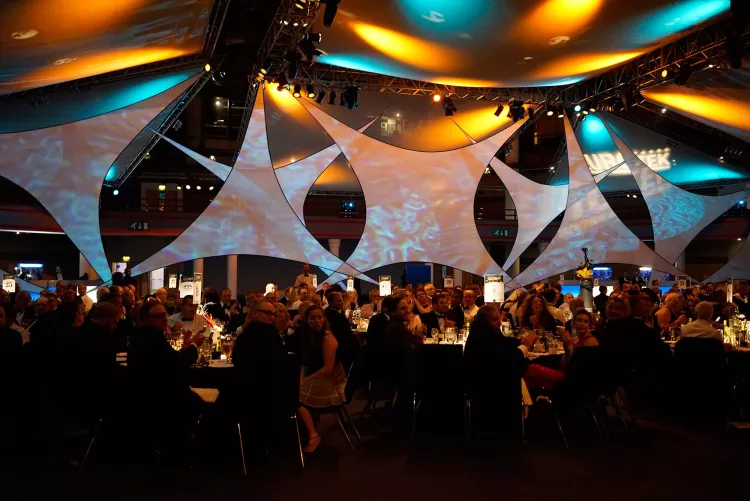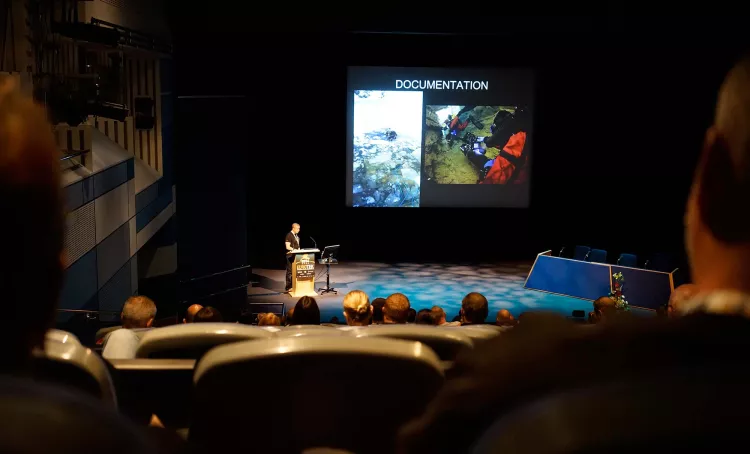Pre-Breathe Effectiveness and Lessons Learned In Lake Mead - EUROTEK 2014 report
EUROTEK, the European biennial advanced and technical diving conference (www.eurotek.uk.com), celebrated its fourth birthday in September. 500 divers from across the globe flocked to The ICC in Birmingham to exchange ideas, meet new divers and hear 28 internationally known experts and explorers deliver 40 different talks during this two-day event.
Associate Professor Simon Mitchell had a busy EUROTEK. He gave two keynote presentations, was the guest after dinner speaker at the Gala Dinner, and won a EUROTEK award.
Pre-breathe effectiveness
Brand new talks are often unveiled at EUROTEK and this event was no different. Dr Mitchell shared two pieces of rather exciting new research with the delegates. His first talk was a much anticipated presentation on the effectiveness of the five minute pre-breathe, that rebreather divers undertake before diving. The question posed was whether this timeframe allows the diver to recognise elevated carbon dioxide levels in the scrubber. This has been a controversial subject and Dr Mitchell along with Dr Neal Pollock, a research associate at the Center for Hyperbaric Medicine and Environmental Physiology at Duke University Medical Center in the USA, devised a study comprising of three scenarios. This was conducted at the University of Auckland earlier this year.
The scenarios were;
* a standard AP Evo Plus rebreather assembled correctly but the scrubber did not contain any dive sorb
* a standard AP Evo Plus rebreather assembled with the scrubber containing sorb, but a key o ring and spacer left out to mimic a partial failure of the scrubber
* a standard AP Evo Plus rebreather assembled correctly with scrubber, dive sorb and all components in place
The rebreather was then set up in the laboratory so that a number of key physiological measurements could be taken during each prebreathe trial; pulse rate, breathing rate, tidal volume (the volume of each breath), minute volume (the volume of gas moved in and out of the lungs each minute), the inspired PCO2 and the end tidal PCO2. The breathing resistance was masked so that the diver subjects would not easily detect differences between the different scrubber conditions.
Each of 30 subjects completed two of the three conditions. They were not told how the rebreather had been set up, just that if they felt any symptoms of CO2 toxicity they should come off the loop immediately. Each was then instructed to conduct their prebreathe as per training recommendations - they sat quietly at rest with their nose blocked.
This study is currently in review for publication in a medical journal, so few details can be provided here. I am able to report that the research team did observe that a number of subjects did not terminate the prebreathe during the partial scrubber failure, or even when no scrubber was present, in some cases despite exhibiting fairly clear symptoms of respiratory distress.
While the prebreathe may not be effective at reliably identifying CO2 issues, the researchers do not advocate that it be scrapped completely. Dr Mitchell reported, "the prebreathe gives the user the opportunity to ensure that other systems (like the oxygen controller) are working correctly. But it does not need to be five minutes long in the belief that this allows detection of problems with the CO2 scrubber."
Sensors
Oxygen sensors proved to be a hot topic during EUROTEK.2014. Simon Mitchell also chaired a session on oxygen sensors presented by John Lamb of Vandagraph and Paul Raymaekers from rEvo Rebreathers. However it is not often that you hear first hand what happens when oxygen sensors fail during a dive.
The USA based National Park Service Submerged Resources Center use rebreathers for extended range diving. Dave Conlin, Chief of the NPSSRC spoke at Rebreather Forum 3 in May 2012 as to why the team had adopted rebreathers. “The real value of rebreathers is not deep diving at all, but staying longer at 20 – 30 metres / 70 – 100 feet. You can work at those depths nearly all day long when the conditions are good. By switching from open circuit onto rebreathers the NPS diver productivity rate has increased by nearly 40%. We gain nearly one day for every three days we are in the field.”
Just under six month later the NPS Pacific West Regional Director issued this statement on 7th November 2012. “On Sunday our colleague Dave Conlin, of the Submerged Resources Center, was seriously injured while diving with his team at Lake Mead. Dave was airlifted in critical condition to University Medical Center in Las Vegas. Today, we heard the wonderful news that Dave has regained consciousness and he is talking.
There is still much to be learned. The quick actions of Dave's team-mates - particularly SRC intern Jessica Keller - SRC professionals on the surface, and Lake Mead's emergency response team, likely saved Dave's life. We will share additional information as we receive it.”
Lessons Learned in Lake Mead
The promise was kept at EUROTEK.2014. Dave Conlin, along with Deputy Chief and Photographer Brett Seymour discussed 'Lessons Learned in Lake Mead'. During a routine training dive to 36 metres / 120 feet, Dave Conlin experienced a dual sensor failure. It resulted in a CNS O2 toxicity hit with seizure and loss of consciousness approximately 30 minutes into the dive. Multiple perspectives were presented by the casualty (Dave) and the Incident Manager (Brett), with the session covering planning, training, equipment manufacturer, control interface, physiology, operations and the subsequent investigation.
What came apparent was that despite human factors, the NPS has a fairly robust set of rescue guidelines. Dave's buddy on the day, Jessica Keller, was a pretty new diver, however, she followed the NPS protocols. If it had not been for her purposeful and quick response to the accident, Dave would have died. Jessica Kelller has subsequently been given an award for her actions.
Two hats
Dr Neal Pollock wears two hats, his other one is as Research Director at Divers Alert Network in America. One subject close to his heart is thermal stress and he has spent many years researching this subject including a number of seasons actively diving Antarctica. Dr Pollock made his EUROTEK debut this year, discussing 24 factors that influence decompression stress, most of which can be altered by divers, and then focusing on thermal physiology and protection in a second presentation.
He highlighted a study that the US Navy Experimental Unit conducted in 2007, dividing dives into descent/bottom and ascent/stop phases and clamping the water temperature in different combinations of 'warm' (36 degrees C / 97 degrees F) and 'cold' (27 degrees C / 80 degrees F) to assess the impact on decompression stress. Whilst we all know it is psychologically a lovely idea to be warm at the start of a dive, this increases ongassing during the descent/bottom phase.
Typically towards the end of the dive, the diver is likely to have chilled down somewhat, impairing gas elimination. You could describe the descent/ascent phases of the dive as 'warm-cold'. Starting and finishing the dive 'cold' does mean that there is minimal gas update and minimal elimination, whilst conducting a dive 'warm-warm' provides the environment for maximum tissue loading and good elimination of gas at the end of the dive.
According to Dr Pollock, in a world of ideal decompression stress, the diver would maintain a 'cool-warm' status. Minimum gas loading at the start of the dive, and efficient off gassing at the end of the dive. Enter stage left a growing trend in adventurous diving; the use of heated devices.
You do need to be quite disciplined when it comes to the use of this equipment
"You do need to be quite disciplined when it comes to the use of this equipment", Neal stated. It is good if the device works correctly throughout the dive, but you have to consider the 'what if' scenario. The worst case can easily arise if a heating device that has been keeping a diver toasty fails at the end of the bottom phase of the dive. In this case you have the perfect storm; tissues loaded with inert gas, and increasingly impaired elimination. "Divers need to have adequate thermal protection to be able to function properly both physically and psychologically. Beyond that level of protection, though, decompression safety should be prioritised over comfort. This is challenging given the natural appeal of active protection systems. Most divers are probably best served by good passive protection, and those who feel the need for active systems should use them thoughtfully."
Heated devices
What is the take home message on heated devices? Where you do need to use them, consider having them switched off, or on the lowest setting at the start of the dive. Then either turn them up, or turn them on as you complete the bottom phase of the dive, to augment controlled inert gas elimination during your ascent. You can further assist your decompression efficiency by employing some light exercise such as gently finning during the latter stage of ascent and during stops.
Importantly, though, the benefits of low intensity exercise is lost and the decompression risk increases with high intensity exercise. Ultimately, well-informed and thoughtful practice can be your best defense. If you are curious to know more about thermal stress and protection, Neal Pollock recently wrote an article for XRay Magazine entitled 'Thermal Stress - Thermal Physiology and Protection for diving'; http://www.xray-mag.com/pdfs/articles/DiveMed_ThermalStress_NealPollock…
Rust
The subject of rust was not forgotten and over the course of two days, 15 wreck talks were presented. When Immi Wallin unveiled what was possibly 'the image' of EUROTEK.2014, strong echoes of the battleship HMS Victoria came to mind. The breathtaking yet tragic photo of U-745 was revealed in the main speaking hall to gasps of wonder. It was obvious this submarine had suffered a dramatic death. Her bow is impaled in the seabed, buried up to the conning tower, with her stern pointing skywards to the surface like some crazy marine sundial at a 45 degree angle.
For nearly seventy years the fate of the lost Kriegsmarine submarine remained a mystery. After a decade of painstaking research and exploration, the Badewanne Team including Immi Wallin and Jouni Polkko finally solved the riddle. During their talk Immi and Jouni spoke about the U-boat warfare in the Gulf of Finland, mainly concentrating on a skirmish that occurred in January 1945 between the Finnish mining ship Louhi and the U-boats.
Other wreck talks included Steve Lewis and Evan Kovacs waxing lyrical about North America's Great Lakes, illustrated by some rather luscious 3D images and footage. Closer to home Barry McGill explored some of the deep wrecks that lie off the coast of North Donegal, whilst José Marques and Armando Ribeiro spoke about the attempt to locate and dive Flight 730, a lost aircraft off Madeira.
Entry Level Tech Diver
The tech curious were also catered for. Dr Rich Walker spoke in the first session on Saturday about 'Entry Level Tech Diver' and provided a useful overview of the steps that a recreational diver should consider. Tips included how to find an instructor, self preparation, factors to consider when setting up diving equipment, when is a good time to move onto a rebreather and how to pick an agency. Everyone who attended his talk left with a memory stick with a bunch of useful PDFs on it. The take home message from this presentation was "do your homework. Have a reason for doing this type of diving. Please do not do it because it is a 'cool badge' or your friends are doing it. Set your goal and then direct your training around your goal."
Narvik wreck diving
On Sunday Rich Walker pined for the fjords as he waxed lyrical about the superb wreck diving Narvik has to offer. It was a talk in two parts. The first covering the history and battle in 1940 with the second part of the talk devoted to what it is like to dive these chilly waters. Narvik is well within the Arctic circle, making it a dream destination destination for all temperate water wreck fiends. The water temperate helps preserve the wrecks, plus there is a strong enforced 'no take' ethos. And depending on when you dive during the year, there is the chance you may well get joined by Orcas. It is possible to get onto the wrecks at 15 metres (loads of bottom time) and the local logistics are simple. Rich spoke about diving the destroyers and ore-carriers from local liveaboard Galten. She is a retired Swedish Navy diving support vessel that has been specifically fitted out for diving operations throughout the Scandinavian winter, ie she benefits from a heated shelter deck, making her a great liveaboard for adventurous divers.
Show and tell
EUROTEK is also the place to get up to speed with the latest equipment and dive centres in the 'show and tell' specialist exhibition. Divers were able to speak to experienced technicians and staff from 33 different international companies without being the given the hard sell. Goodies on hand included lights from Ammonite, Deep Ideas, Green Force, Light Monkey and Northern Light Scuba. Alleco unveiled their underwater tablet, whilst IANTD, PADI and TDI were on hand to answer queries and advise on future training. The Cave Diving Group livened up proceedings by bringing along the Wessex Caving Club Squeeze Machine. Despite it resembling a torture device, a number of luminaries queued up to see just how big their butt was.
Gala Awards Dinner
Success and friendship was celebrated on Saturday evening at the glittering EUROTEK Gala Awards Dinner. The ICC certainly excels when it comes to cooking gourmet food and the four course gala award dinner was hungrily devoured before the raffle was drawn. £4,000 was raised for the Rubicon Foundation thanks to Ammonite, Kent Tooling Diving Products, Prism Design, Rod Roddenbury and Roddenbury Adventures, Otter Drysuits, Pete Mesley's Lust4Rust and Suex Scooters for being so thoughtful and generous with their donations. What is rather exciting to announce is that AP Diving and Suex Scooters have already confirmed that they will be respectively donating a fully loaded rebreather and a DPV for the EUROTEK.2016 raffle.
The six EUROTEK awards were announced. Divers from around the world decide who wins and who doesn't, by democratically voting for their favourite diving personalities, equipment and services. Voting for 2016 awards will be going online in due course.
New Award
This year a new award was announced; the 'Discovery' Award. This recognises an individual or a team who has made significant discoveries in the field of advanced or technical diving. Be it a wreck, a cave, a new teaching or training technique, or a new piece of research.
This inaugural Discovery award was given to Associate Professor Simon Mitchell for his prolific work to help us understand and safely enjoy the underwater realm. He actively gets his new discoveries out there by publishing and talking about his research, so that divers can prepare through proper dive education. He has authored or co-authored 206 documents, including 57 referred scientific journal articles; written a number a number of chapters in four books and he sits on three editorial boards; the Journal for Extracorporeal Technology, the Undersea and Hyperbaric Medicine Board, the Diving and Hyperbaric Medicine Board.
Simon Mitchell was also the lead author on the paper "Recommendations for rescue of a submerged unresponsive compressed-gas diver". This was published in the Undersea and Hyperbaric Medicine journal. What was unique about this research, was that Simon gained permission for the paper to be shared immediately, and for free, with the recreational and technical diving community, and it was also presented at EUROTEK.2014. If you want to access a free copy of this invaluable paper, log onto The Dive Forum.
The EUROTEK Award for Innovation is given to an advanced or technical diving product or service, that has enabled others to further their diving or made diving safer. This year it was given to a company founded in 2004 that sought to build an intuitive user interface for dive computers and rebreather control systems. Bruce and Lynn Partridge of Shearwater Research understand that divers like being offered reasonable choices on a dive, requiring as few button pushes as possible. They received the award for the NERD and Petrel. (What makes their Petrel computer unique is that the system also incorporates evidence based scientific research).
For the fourth year running, the EUROTEK Media award was given to a publication. (This award can also be given to an advanced or technical diving film, programme or publication that has educated, inspired or influenced divers.)
The award winner is not a typical diving book. In fact the publication took five years of work. It took three years of planning and two years of editing. Opinions and advice was given from leading experts from around the world including manufacturers, training agencies, instructors and end users. There were contributions from doctors, the armed forces, the media, NATO, the HSE, and scientific divers. In fact all communities who had anything to do with this aspect of rebreather diving were involved. Today the 'Rebreather Forum 3 Conference Proceedings' are available for free for anyone, anywhere to download, just follow this link; http://bit.ly/1lfhzms Dr Neal W Pollock, one of the editors of the Proceedings received the award on behalf of the three editors.
The EUROTEK Outstanding contribution to the Industry Award is given to a dedicated individual who has gone the extra mile in their work, and supported the dive industry by developing and contributing to advanced and technical diving.
Mark Evans, Editor of Sport Diver Magazine has lent a huge amount of support to the UK diving scene in the last decade. There is no denying his overwhelming passion for the sport, and it is this impression most people take away when meeting him. Sport Diver Magazine has brought us features and stories not only of great dive sites, but also given us details on some of the UK's top manufacturers new and exciting products.
Mark Evans has shown support for the industry which goes beyond simple reportage. Amongst the many comments received during this voting process, this one resonated; “We welcome his new approach to writing about tech diving. He aims to be inclusive rather exclusive. He goes all out to promote tech diving positively and without all the gorey stories. He keeps it fresh, fun and photo driven, when the other magazines have started to look stale and old”.
The fifth EUROTEK Award is the lifetime achievement award and it is given in memory of EUROTEK co-founder Carl Spencer. This is given to an individual for their consistent contributions to equipment, discoveries or education that have advanced or opened up the field of Technical Diving and advanced diving. The 2014 recipient, Lamar Hires of Dive Rite, has made his mark in the community on two fronts; equipment and education.
Lamar Hires started diving in 1979. He liked diving in springs because it meant he didn't have to dive off a boat. It was only a matter of time before spring diving became cave diving. And in 1984, after five years of cave diving and logging over 1,000 dives, he earned his cave instructor stripes with the NSS-CDS.
His motivation to explore lead him to design and develop new equipment and techniques. In the USA Lamar was one of the first to use side mount techniques to push caves. He used this knowledge and experience to write the first NSS-CDS Si demount course in 1985. He is rather surprised at just how side mount diving has taken off. “I would have never thought it would become the open water diving style it is today.”
He is passionate about cave rescue and recovery, and helped produce and star in the safety film called “A deceptively easy way to die”. Having trained over 650 people to cave dive, he is still an active instructor, and continues to teach rebreather, side mount and cave courses.
His company is a recognised and respected name throughout the world. He developed the first back mounted wing specifically for carrying a heavy twinset, called 'the Classic Wing'. And in the mid 80's he mass produced the backplate that is widely used by technical divers. In 1992 he worked with SEIKO EPSON to develop the first user programmable nitrox computer, the “Bridge”. Ten years ago I remember him introducing the first combined helium and oxygen analyser. Today it is a normal tool for any advanced diver. Back then, this was a cutting edge piece of kit.
The final EUROTEK award, the 'Diver of the conference', is given to the individual who has achieved outstanding milestones within the sport of advanced and Technical diving. The winner, Jason Mallinson had already discussed the loneliest cave dive earlier in the day when he spoke about the Pozo Azul. He started this project in northern Spain in 2001 and it is now considered to be the longest and possibly the most logistically complex cave diving penetration in the world.
Jason Mallinson is known throughout his community for his significant exploration of virgin caves, extreme penetration, and setting world distance records. He has spearheaded numerous explorations worldwide and has a contagious passion for both discovery and exploration; he relentlessly dives in extreme locations often at the bottom of some of the planets deepest caves. Key expeditions include the Emergence de Ressel in France and Bill Stones three-month long Wakulla II project.
In 2004 he was sent to Mexico (along with Rick Stanton) to help rescue six military personnel who had been trapped in a flooded cave for 10 days. As a result of the success of that rescue he has since been called to other countries to deal with complex underwater cave incidents.
EUROTEK.2016
Planning for EUROTEK.2016 is already underway. If you would like to be considered as a speaker, please contact Leigh Bishop; leigh@eurotek.uk.com
If you wish to be a sponsor or exhibitor, please contact Rosemary E Lunn; roz@tumc.co.uk Missed out? Or already a EUROTEK fan? If you want to hear exciting diving stories from renowned explorers and experts, the date for your diary is Saturday 8th and Sunday 9th October 2016 at The ICC, Birmingham, England. You don't need to be an ardent techie to attend this. Just a diver or instructor hungry to know more about diving. Whether you are an enthusiastic diver, a hard-core techie, cutting edge explorer or simply interested in spicing up your diving, you will leave empowered and enthused.
- Log in to post comments



